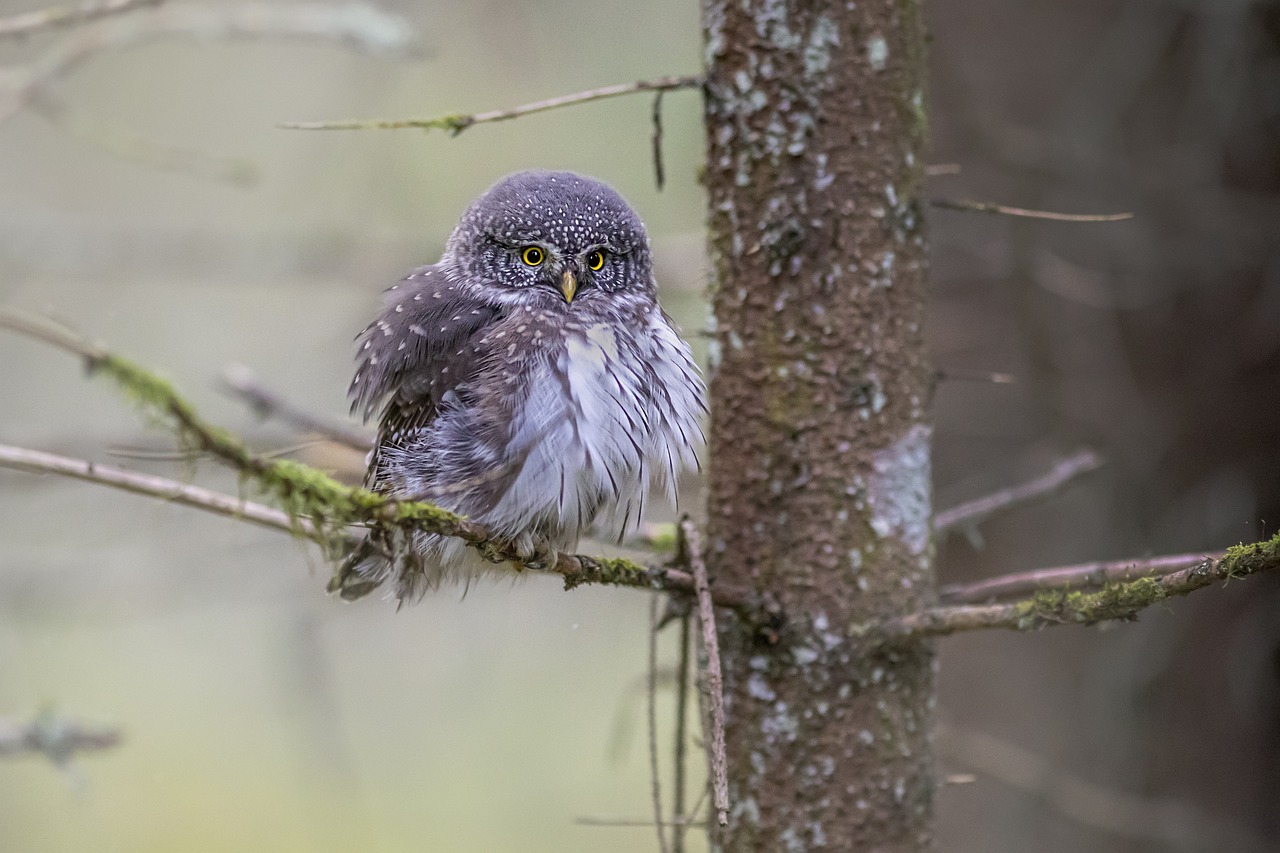The Eurasian Pygmy Owl (Glaucidium passerinum) is a small, elusive bird of prey known for its diminutive size and distinctive appearance. It belongs to the family Strigidae, which includes true owls.
Description
- Appearance:
- Size: The Eurasian Pygmy Owl is one of the smallest owls, with a body length of about 16-18 centimeters (6.3-7.1 inches) and a wingspan of 38-43 centimeters (15-17 inches). It typically weighs between 70-110 grams (2.5-3.9 ounces).
- Coloration:
- Feathers: The plumage is generally mottled brown and white, providing effective camouflage in its forest habitat. The back is brown with white spots, while the underside is paler with streaks.
- Face: It has a distinctive facial disc with a small, round face and yellow eyes that contrast sharply with its dark beak.
- Other Features: It has a short, stubby tail and relatively short wings, which are characteristic of its small size.
Habitat
- Distribution: The Eurasian Pygmy Owl is found across northern Europe and Asia, extending from Scandinavia and the British Isles to Siberia and parts of Japan. It is a resident species in many of these regions.
- Preferred Environment: It inhabits dense coniferous and mixed forests, particularly those with abundant undergrowth. It is often found in mature forests with plenty of hiding spots.
Behavior and Ecology
- Hunting and Diet:
- Prey: The Eurasian Pygmy Owl primarily feeds on small mammals, birds, insects, and other invertebrates. Its diet can vary depending on the availability of prey in its habitat.
- Hunting Style: It is an ambush predator, often using its excellent camouflage to remain hidden until it spots prey. It hunts from a perch, swooping down quickly to capture its target.
- Vocalization:
- Calls: The owl’s call is a high-pitched, repetitive “tu-tuk-tuk-tuk,” which is often described as sounding like a series of rapid, soft whistles. These calls are used for communication and territorial defense.
- Breeding:
- Nesting: The Eurasian Pygmy Owl nests in tree cavities or old nests of other birds. It does not build its own nest but uses available cavities or abandoned nests.
- Eggs: The female typically lays 4-7 eggs, which she incubates while the male provides food. The chicks fledge about 3-4 weeks after hatching.
- Behavior:
- Activity: It is primarily nocturnal but can also be active during the day, especially in the early morning and late afternoon. It tends to be solitary, except during the breeding season.
- Camouflage: Its plumage helps it blend into its forest environment, making it challenging to spot even when it is perched in plain sight.
Conservation
- Status: The Eurasian Pygmy Owl is generally not considered endangered. It has a stable population across its range and is not currently facing significant threats.
- Conservation Efforts: Efforts to preserve its habitat, particularly intact and mature forests, are important for maintaining healthy populations. Habitat destruction and changes in forest management can impact its habitat.
Observing Eurasian Pygmy Owls
- Best Times: They are most active at dawn and dusk, though they can also be observed during the day.
- Watching Tips: Look for them in dense forests and listen for their distinctive calls. Their small size and excellent camouflage can make them challenging to spot, so patience and keen observation are required.
Interesting Facts
- Size: Despite its small size, the Eurasian Pygmy Owl is a formidable predator with sharp talons and an impressive hunting ability.
- Camouflage: Its plumage provides excellent camouflage in its forest habitat, making it difficult for both prey and predators to detect.
Summary
The Eurasian Pygmy Owl (Glaucidium passerinum) is a small, elusive owl known for its distinctive appearance and behavior. Found across northern Europe and Asia, it inhabits dense coniferous and mixed forests. Its diet includes small mammals, birds, and insects, and it uses its excellent camouflage to remain hidden from both prey and predators. Despite its small size, it plays a significant role in its ecosystem as a skilled predator.
Visited 101 times, 23 visit(s) today
Views: 175
Subscribe to the newsletter:
